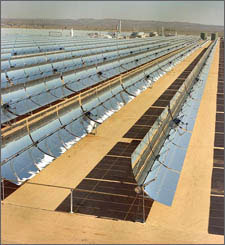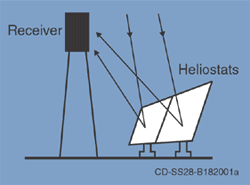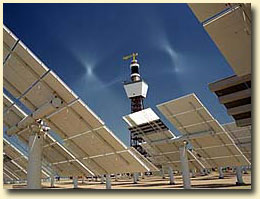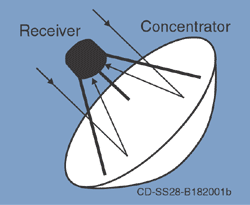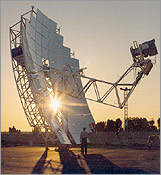
|
|
|
|
|
Concentrating Solar Power (CSP) TechnologiesConcentrating Solar Power (CSP) technologies use mirrors to concentrate (focus) the sun's light energy and convert it into heat to create steam to drive a turbine that generates electrical power. CSP technology utilizes focused sunlight. CSP plants generate electric power by using mirrors to concentrate (focus) the sun's energy and convert it into high-temperature heat. That heat is then channeled through a conventional generator. The plants consist of two parts: one that collects solar energy and converts it to heat, and another that converts the heat energy to electricity. A brief video showing how concentrating solar power works (using a parabolic trough system as an example) is available from the Department of Energy Solar Energy Technologies Web site. Within the United States, CSP plants have been operating reliably for more than 15 years. All CSP technological approaches require large areas for solar radiation collection when used to produce electricity at commercial scale. CSP technology utilizes three alternative technological approaches: trough systems, power tower systems, and dish/engine systems. Trough Systems
Click a photo below to view interactive panoramas of parabolic trough facilities.  SEGS IX Parabolic Trough 360° - Interactive Panorama. Source: Argonne National Laboratory  Nevada Solar One Parabolic Trough - 360° Interactive Panorama. Source: Argonne National Laboratory Power Tower Systems
Click the photo below to view interactive panorama of a power tower facility.  eSolar Sierra Suntower Power Tower Facility - Interactive Panorama. Source: Argonne National Laboratory Dish Engine Systems
Photovoltaic Solar TechnologiesThe Solar Energy Development PEIS will also consider environmental impacts associated with photovoltaic (PV) solar energy technologies; see the Solar Photovoltaic (PV) Technologies page to learn more. Additional ResourcesThe following documents are technical summaries of CSP technologies prepared by the National Renewable Energy Laboratory.
|






